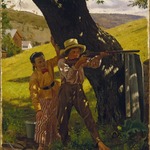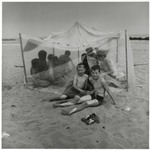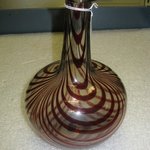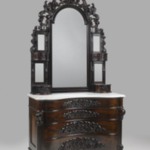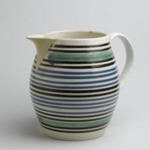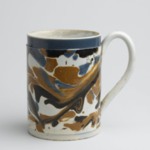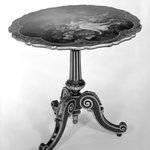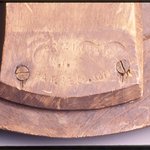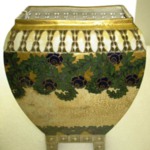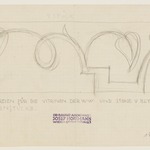

Gebrüder Thonet (Austrian, founded Vienna, 1842). Child's Armchair, ca. 1875. Copper beech, modern caning, metal screws, 24 3/4 x 14 x 17 1/4 in. (62.9 x 35.6 x 43.8 cm). Brooklyn Museum, Gift of Dr. Barry R. Harwood, 83.155. Creative Commons-BY (Photo: Brooklyn Museum, 83.155_PS6.jpg)
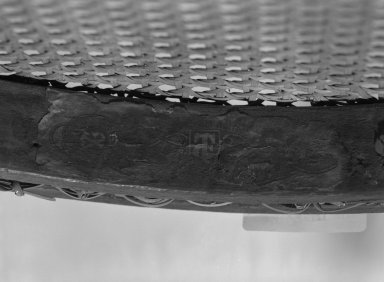
Gebrüder Thonet (Austrian, founded Vienna, 1842). Child's Armchair, ca. 1875. Copper beech, modern caning, metal screws, 24 3/4 x 14 x 17 1/4 in. (62.9 x 35.6 x 43.8 cm). Brooklyn Museum, Gift of Dr. Barry R. Harwood, 83.155. Creative Commons-BY (Photo: Brooklyn Museum, 83.155_mark_bw.jpg)
Child's Armchair
Decorative Arts and Design
Michael Thonet (1796-1871)
Bentwood furniture, perhaps the most ubiquitous type of furniture worldwide, is indebted to the nineteenth-century innovations of Michael Thonet. Although the process—which involves steaming wood and bending it into curved shapes—had been used since ancient times to manufacture not only furniture but also wheels, barrels, and boat hulls, Thonet’s application of it in the 1830s was revolutionary. Thonet was the first designer to fuse the means of production and design to create superior products: his chairs were stronger, lighter, and less expensive than traditionally made ones. He was also a master of marketing, selling his designs through catalogues and an international chain of stores. He offered the same piece of furniture in different colors, and he produced pieces for adults, children, and even dolls (as seen here) to capture as much of the consumer market as possible.
Bentwood furniture, perhaps the most ubiquitous type of furniture worldwide, is indebted to the nineteenth-century innovations of Michael Thonet. Although the process—which involves steaming wood and bending it into curved shapes—had been used since ancient times to manufacture not only furniture but also wheels, barrels, and boat hulls, Thonet’s application of it in the 1830s was revolutionary. Thonet was the first designer to fuse the means of production and design to create superior products: his chairs were stronger, lighter, and less expensive than traditionally made ones. He was also a master of marketing, selling his designs through catalogues and an international chain of stores. He offered the same piece of furniture in different colors, and he produced pieces for adults, children, and even dolls (as seen here) to capture as much of the consumer market as possible.
MANUFACTURER
Gebrüder Thonet, Austrian, founded Vienna, 1842
MEDIUM
Copper beech, modern caning, metal screws
DATES
ca. 1875
DIMENSIONS
24 3/4 x 14 x 17 1/4 in. (62.9 x 35.6 x 43.8 cm)
seat height: 12 in. (30.5 cm) (show scale)



MARKINGS
Paper label affixed to inside of seat frame; dirty with some fragments missing. Long,oval-shaped design within rectangular label, with elaborate interlaced pattern. The crossed letters "GT" in the center and at each end.
COLLECTIONS
Decorative Arts and Design
ACCESSION NUMBER
83.155
CREDIT LINE
Gift of Dr. Barry R. Harwood
CATALOGUE DESCRIPTION
Child's armchair (MODEL NO. 14), central European copper beechwood, composed of five parts: long, horseshoe-shaped piece comprising continuous rear legs, stiles and back; set into back is short horseshoe-shaped splat; two identical L-shaped arms starting at the front of the back, curving down to form arms and front legs; inserted between stiles and front legs is a round, caned seat, made from one continuous member.
CONDITION - Proper right arm slightly loose. Finish was lightened long ago (considerable patina). Several surface cracks to outer edge of splat. Small area of green substance on seat frame and cane at proper right rear. Numerous minor scuffs and scratches to surfaces, some white stains to seat frame and lower legs.
EXHIBITIONS
MUSEUM LOCATION
This item is not on view
CAPTION
Gebrüder Thonet (Austrian, founded Vienna, 1842). Child's Armchair, ca. 1875. Copper beech, modern caning, metal screws, 24 3/4 x 14 x 17 1/4 in. (62.9 x 35.6 x 43.8 cm). Brooklyn Museum, Gift of Dr. Barry R. Harwood, 83.155. Creative Commons-BY (Photo: Brooklyn Museum, 83.155_PS6.jpg)
IMAGE
overall, 83.155_PS6.jpg. Brooklyn Museum photograph, 2011
"CUR" at the beginning of an image file name means that the image was created by a curatorial staff member. These study images may be digital point-and-shoot photographs, when we don\'t yet have high-quality studio photography, or they may be scans of older negatives, slides, or photographic prints, providing historical documentation of the object.
RIGHTS STATEMENT
Creative Commons-BY
You may download and use Brooklyn Museum images of this three-dimensional work in accordance with a Creative Commons license. Fair use, as understood under the United States Copyright Act, may also apply.
Please include caption information from this page and credit the Brooklyn Museum. If you need a high resolution file, please fill out our online application form (charges apply).
For further information about copyright, we recommend resources at the United States Library of Congress, Cornell University, Copyright and Cultural Institutions: Guidelines for U.S. Libraries, Archives, and Museums, and Copyright Watch.
For more information about the Museum's rights project, including how rights types are assigned, please see our blog posts on copyright.
If you have any information regarding this work and rights to it, please contact copyright@brooklynmuseum.org.
RECORD COMPLETENESS
Not every record you will find here is complete. More information is available for some works than for others, and some entries have been updated more recently. Records are frequently reviewed and revised, and we welcome any additional information you might have.






